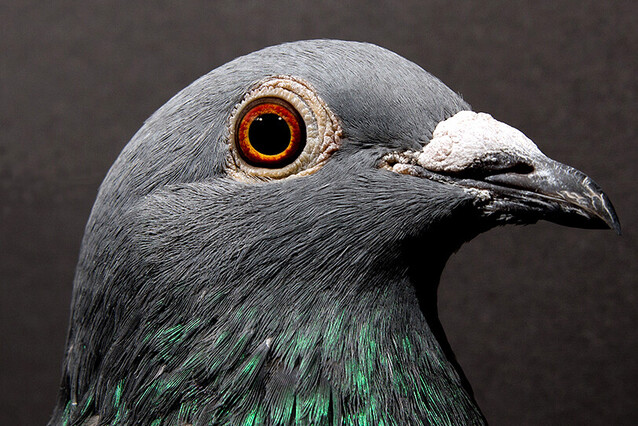A clue on how pigeons "see" the Earth’s magnetic field
Many animals have a sense to detect the Earth’s magnetic field, demonstrated most impressively by seasonal journeys of migratory birds. The molecular and cellular mechanisms underlying this sense, however, remain unknown. In the journal Science Advances, David Keays and collaborators now report an important piece in solving the puzzle: they characterised a candidate molecule for a light-based magnetic field detector.
From European eels that spawn in the Sargasso Sea, to migratory birds that swap hemispheres to spend winter in warmer realms – many animals navigate over long distances using the Earth’s magnetic field as reference point. The sense to detect magnetic force is not limited to migratory species, though. Newts, bats, mole rats, as well as invertebrates such as bees, cockroaches or lobsters have also been shown to have an inner compass. But while examples and behavioural evidence for magnetoreception are abundant, the question of how animals do this remains unresolved.
There are three main models that offer possible frameworks for the molecular and cellular basis of a magnetic sense: iron crystals within mechanosensory cells; tiny currents within the inner ear that are generated by movement through the magnetic field; or a quantal compass known as “Radical Pair Mechanism” (RPM).
Light-induced radical pairs can exist in one of two possible states, parallel or anti-parallel. Spin state probability would be influenced by local magnetic fields, which – if the radical pairs are long-lived - could place this mechanism at the core of a signalling chain that would ultimately involve a receptor protein. David Keays, who reported clues for the induction model only last December, has now characterised a candidate for a light-based RPM in pigeons.
Free electrons as the needle in the inner compass
Strong support for the Radical Pair Mechanism model comes from observations that magnetic orientation in many animals depends on the presence of light, often at certain wavelengths that are species-specific. Radiofrequency fields that interfere with the spins of radical pairs, on the other hand, have been shown to disrupt the inner compass of several species, including European robins.
David Keays’ lab and collaborators now turned to a group of molecules that have long been considered a possible source for the magnetic sense: cryptochromes. These are signalling molecules that can be found across the animal kingdom. They often play a role in the regulation of circadian rhythms – the “inner clock” of animals.
In their most recent work, Keays and his lab investigate whether a cryptochrome found in birds (CRY4) possesses the necessary molecular and biophysical attributes to act as a compass: “The primary sensors for a magnetic field should be aligned in a meaningful way to provide directional information”, says Keays. “And they need to be linked to a still unknown intracellular signalling mechanism that would allow for the modulation of neuronal activity.”
Using spectroscopic methods, the scientists could show that the pigeon cryptochrome is indeed photoreduced by light, and forms long-lived radical pairs. In this state, the molecules could trigger a signalling cascade that would ultimately activate a sensory neuron.
Cryptochrome: link between magnetic input and neuronal output?
The scientists then investigated the expression patters of clCRY4 and found it enriched in the outer plexiform layer, a layer of neuronal synapses in the retina of the eye. The molecule is not evenly spread. Rather, it forms patterns, little discs that transverse the retina in an ordered fashion. “This ordering is intriguing”, says Keays, “as it may result in maximal activation depending on the orientation of the animal to the magnetic field”.
The scientists also identified a range of molecules that can interact with clCRY4, including GRIP1 and GRIP2. GRIP proteins have been linked to the trafficking of glutamate receptors to the synapse and the coupling of these receptors to intracellular machinery. This finding is important, as it might explain how a magnetic input is coupled to a neuronal output.
Taken together, Keays’ findings show that clCRY4 could act as a light-dependent detector of magnetism, modulating glutamergic synapses between horizontal cells and cones.
“It’s an exciting time. For more than 50 years we have known that the magnetic sense exists, but it has been a sense without a receptor. CRY4 might well be the mysterious molecule we have all been looking for – a quantal compass that has evolved over millennia.”
---
Original Publication
T. Hochstoeger, T. Al Said, D. Maestre, F. Walter, A. Vilceanu, M. Pedron, T. D. Cushion, W. Snider, S. Nimpf, G. C. Nordmann, L. Landler, N. Edelman, L. Kruppa, G. Dürnberger, K. Mechtler, S. Schuechner, E. Ogris, E. P. Malkemper, S. Weber, E. Schleicher, D. A. Keays
(2020):
“The biophysical, molecular, and anatomical landscape 1 of pigeon CRY4: a candidate light based quantal magnetosensor”. Science Advances, DOI: 10.1126/sciadv.abb9110
About the IMP at the Vienna BioCenter
The Research Institute of Molecular Pathology (IMP) in Vienna is a basic biomedical research institute largely sponsored by Boehringer Ingelheim. With over 200 scientists from 40 countries, the IMP is committed to scientific discovery of fundamental molecular and cellular mechanisms underlying complex biological phenomena. The IMP is part of the Vienna BioCenter, one of Europe’s most dynamic life science hubs with 1,850 employees from 70 countries in four research institutes, three universities and 35 biotech companies. www.imp.ac.at, www.viennabiocenter.org
